A319neo completes maiden flight as joint 737 MAX technical review commences.
by J. Kasper Oestergaard, European Correspondent, Forecast International.
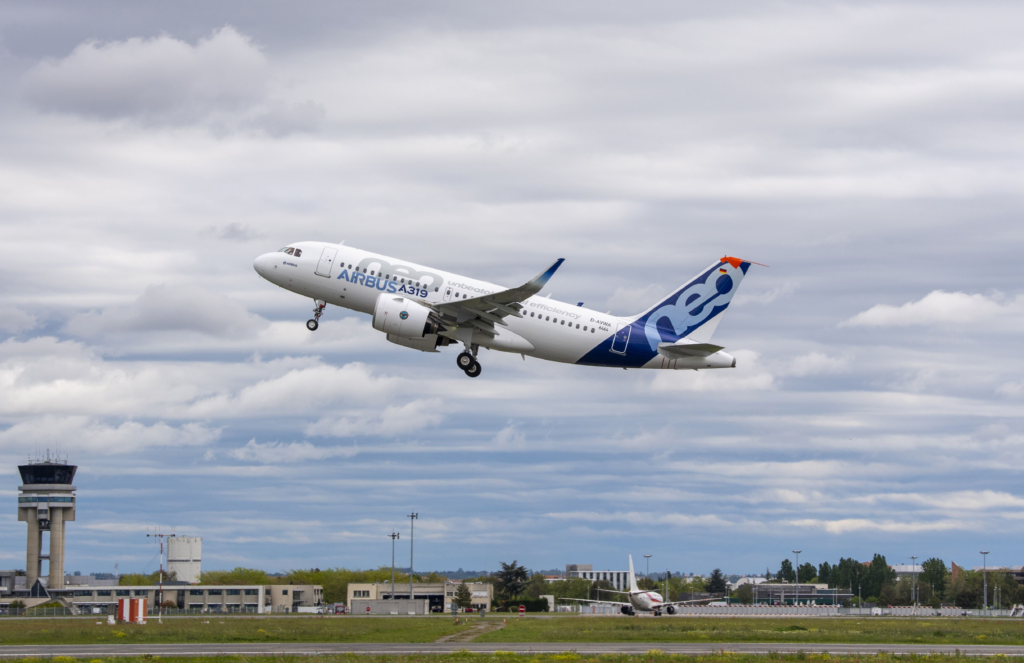
Boeing and Airbus delivered 23 and 70 commercial jets in April 2019 compared to 44 and 51 deliveries, respectively, in the same month last year. Boeing’s deliveries have taken a severe hit following the March 10 crash of Ethiopian Airlines Flight 302, a 737 MAX, and the subsequent deliveries halt and grounding of the fleet. Boeing decided on March 14 to suspend all deliveries of 737 MAX jets. The crashes were with a high degree of certainty caused by the aircraft’s Maneuvering Characteristics Augmentation System (MCAS), which suddenly activated in response to erroneous angle of attack information. In 2018, Boeing delivered 806 jets (763 in 2017) with Airbus handing over 800 (718 in 2017). With 172 deliveries this year to date, Boeing is 56 shipments behind last year’s total for the first four months of the year. Airbus has delivered a total of 232 jets from January to April compared to just 172 during the same period last year.
In April 2019, Boeing delivered nine 737s (of which none were 737 MAXs). Boeing is still producing 737 MAX jets at a reduced rate and thereby building up an inventory of aircraft ready to be shipped. During 2018, Boeing raised its 737 production rate to 52 and was planning for a further increase to 57 per month from early June this year. In the aftermath of the 737 MAX crashes, Boeing has decided to temporarily reduce its 737 production rate to 42 per month from April 15. This will allow the company to prioritize additional resources to focus on software certification and returning the 737 MAX to flight. As of April 11, Boeing had made 96 flights to test their MCAS software update. According to Boeing CEO Dennis Muilenburg, during test flights, the software update has functioned as designed. The company now awaits regulatory approval for its software fix. The FAA has established a Boeing 737 MAX Joint Authorities Technical Review (JATR) chaired by former NTSB Chairman Chris Hart and comprised of a team of experts from the FAA, NASA, and international aviation authorities. The review sessions commenced on April 29 and aspects of the 737 MAX automated flight control system, including its design and pilots’ interaction with the system, will be reviewed to determine its compliance with regulations and to determine if any further improvements are needed. The JATR’s work is expected to take 90 days. To date, Boeing has delivered 387 737 MAXs of which 57 were delivered in Q1 2019; 256 737 MAX jets were delivered in 2018, up from 74 in 2017. During April 2019, Boeing also delivered one 747-8F, one 777 and 12 787s. Boeing is currently in the process of raising the monthly Dreamliner production rate to 14 aircraft. Boeing delivered 145 787s in 2018, up from 136 in 2017.
In April 2019, Airbus delivered three A220s, 57 A320s (10 ceo / 47 neo), two A330s, and eight A350s. A total of 386 A320neo Family aircraft were delivered in 2018, up from 181 and 68 in 2017 and 2016, respectively. By mid-2019, Airbus expects to deliver 60 A320 jets per month on average. The company has internally been debating rates above 60 aircraft. Airbus delivered 93 A350s in 2018, up from 78 in 2017, and recently increased the monthly production rate to 10. Airbus is considering a further increase up to 13 A350s per month. With the ramp-up of A350 XWB deliveries combined with a higher A320 production rate, Airbus has nearly eliminated Boeing’s deliveries lead in recent years. Following the tragic 737 MAX events, in 2019, Airbus is looking set to deliver more aircraft versus Boeing.
With just four gross orders in April, Boeing had a terrible month in the orders race. The company also debooked 210 jets (ASC 606 adjustment) due to severe financial turmoil at India’s Jet Airways. The only order this month was for four 737 MAX jets for an undisclosed customer. For the full year 2018, Boeing managed to book 893 net new orders (1,008 gross orders).

Due to a surge in cancellations, Airbus is not faring much better than Boeing in the orders race. In April, Airbus booked five gross orders but also reported five cancellations. The April cancellations were preceded by 17 cancellations in March, 90 in February, and 13 in January. Of the 125 cancellations this year to date, 31 are A380s due to Emirates’ decision to reduce its A380 orders book. This decision subsequently forced Airbus to announce that it will cease A380 production in 2021. In April, Lufthansa ordered three additional A350-900s following the airline’s order for 20 A350-900s placed last month. Also, Uganda Airlines placed an order for two A330-800s. In 2018, Airbus landed a total of 747 net new orders (831 gross orders), thereby losing the 2018 orders race as Boeing had accumulated 893 net new orders. Airbus had retained an orders lead over its rival every year since 2012.
On April 30, 2019, Airbus backlog was 7,287 jets, of which 6,319 or 87 percent are A220 and A320ceo/neo Family narrowbodies, not far below the company’s all-time backlog record high of 7,577 jets set in December 2018. By the end of April 2019, Boeing’s backlog (total unfilled orders before ASC 606 adjustments) was 5,866 aircraft (of which 4,690 or 80 percent are 737 NG/MAX narrowbody jets). Boeing’s all-time backlog high of 5,964 aircraft was set in August 2018. The number of Airbus aircraft to be built and delivered represents 9.1 years of shipments at the 2018 production level. By comparison, Boeing’s backlog would “only” last 7.3 years. In 2018, Boeing boasted a book-to-bill ratio of 1.11 with Airbus at 0.93. In 2017, Boeing booked 912 net new orders for a book-to-bill ratio of 1.20. That same year, Airbus booked 1,109 net new orders for a book-to-bill ratio of 1.54.
2019 Forecast
Forecast International’s Platinum Forecast System® is a breakthrough in forecasting technology which – among many other features – provides 15-year production forecasts. The author has used the Platinum Forecast System® to retrieve the latest delivery forecasts and for 2019, Forecast International’s analysts expect Boeing and Airbus to deliver 811 and 875 large commercial jets, respectively. The 2019 total forecast for Boeing was 904 prior to the second 737 MAX crash and the subsequent grounding of the fleet and temporary cut in production rate. These are the latest “live” forecast figures (adjusted frequently by our analysts as new information comes in). These figures are excluding militarized variants of commercial platforms such as Boeing’s P-8 Poseidon, KC-46 and KC-767 tankers, the C-40, and Airbus’ A330 MRTT tanker program.
Prior to the second 737 MAX crash, in connection with the release of its 2018 earnings report in late January, Boeing announced it was targeting between 895 and 905 commercial jet deliveries in 2019, a 12-13 percent increase from 2018. Boeing will likely provide updated guidance later this year. On February 14, Airbus announced that it aims for 880 to 890 commercial aircraft deliveries in 2019, equal to a 10-11 percent increase from 2018.
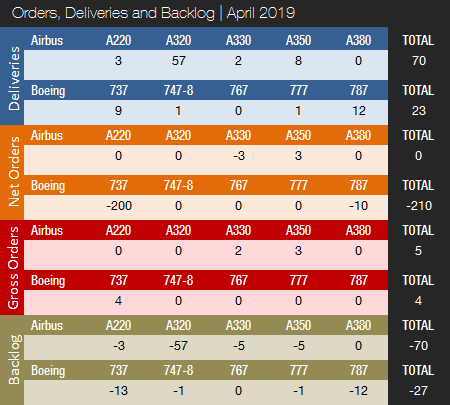

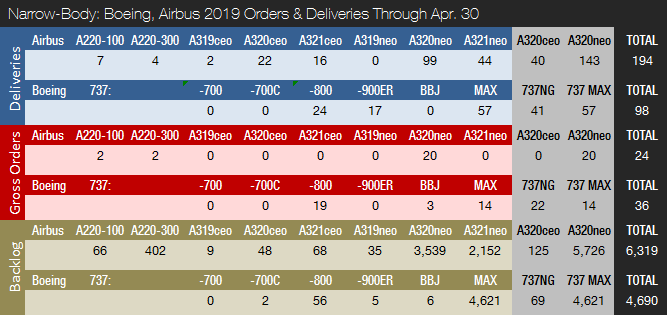
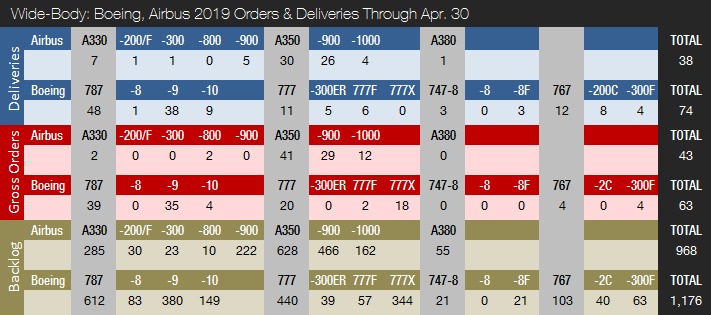
Note: Boeing 777-300ER category includes one 777-200LR order placed in October 2018.
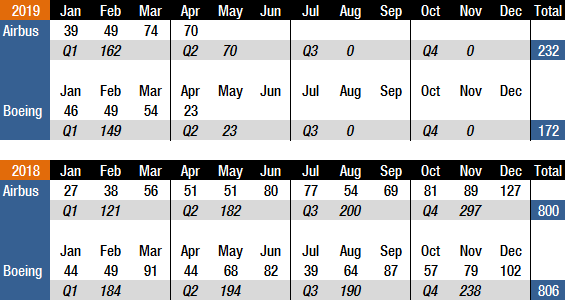

Joakim Kasper Oestergaard is Forecast International’s AeroWeb and PowerWeb Webmaster and European Editor. In 2008, he came up with the idea for what would eventually evolve into AeroWeb. Mr. Oestergaard is an expert in aerospace & defense market intelligence, fuel efficiency in civil aviation, defense spending and defense programs. He has an affiliation with Terma Aerostructures A/S in Denmark – a leading manufacturer of composite and metal aerostructures for the F-35 Lightning II. Mr. Oestergaard has a Master’s Degree in Finance and International Business from the Aarhus School of Business – Aarhus University in Denmark.
References:
- http://www.boeing.com/commercial/#/orders-deliveries
- https://www.airbus.com/aircraft/market/orders-deliveries.html
- https://www.faa.gov/news/updates/?newsId=93206
- https://www.airbus.com/newsroom/press-releases/en/2019/04/pw-powered-a319neo-makes-maiden-flight.html
- https://finance.yahoo.com/news/boeing-737-max-joint-governmental-review-begin-april-211044270–finance.html
- https://www.reuters.com/article/us-boeing-results-jet/boeing-axes-210-orders-after-indias-jet-stops-flying-idUSKCN1S01WA
A military history enthusiast, Richard began at Forecast International as editor of the World Weapons Weekly newsletter. As the Internet grew in importance as a research tool, he helped design the company's Forecast Intelligence Center and currently coordinates the EMarket Alert newsletters for clients. Richard also manages social media efforts, including two new blogs: Defense & Security Monitor, covering defense systems and international issues, and Flight Plan, which focuses on commercial aviation and space systems. For over 30 years, Richard has authored the Defense & Aerospace Companies, Volume I (North America) and Volume II (International) services. The two books provide detailed data on major aerospace and defense contractors. He also edits the International Contractors service, a database that tracks all the contractors involved in the programs covered in the FI library. More recently he was appointed Manager, Information Services Group (ISG), a new unit that encompasses developing outbound content for both Forecast International and Military Periscope.




